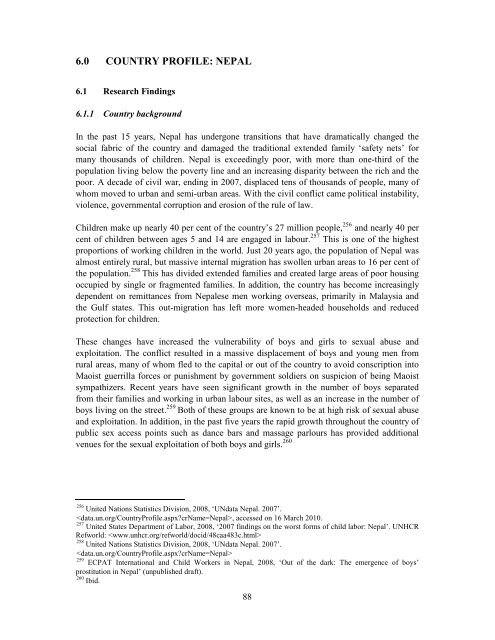SEXUAL ABUSE AND EXPLOITATION OF BOYS IN SOUTH ASIA A ...
SEXUAL ABUSE AND EXPLOITATION OF BOYS IN SOUTH ASIA A ...
SEXUAL ABUSE AND EXPLOITATION OF BOYS IN SOUTH ASIA A ...
You also want an ePaper? Increase the reach of your titles
YUMPU automatically turns print PDFs into web optimized ePapers that Google loves.
6.0 COUNTRY PR<strong>OF</strong>ILE: NEPAL<br />
6.1 Research Findings<br />
6.1.1 Country background<br />
In the past 15 years, Nepal has undergone transitions that have dramatically changed the<br />
social fabric of the country and damaged the traditional extended family ‘safety nets’ for<br />
many thousands of children. Nepal is exceedingly poor, with more than one-third of the<br />
population living below the poverty line and an increasing disparity between the rich and the<br />
poor. A decade of civil war, ending in 2007, displaced tens of thousands of people, many of<br />
whom moved to urban and semi-urban areas. With the civil conflict came political instability,<br />
violence, governmental corruption and erosion of the rule of law.<br />
Children make up nearly 40 per cent of the country’s 27 million people, 256 and nearly 40 per<br />
cent of children between ages 5 and 14 are engaged in labour. 257 This is one of the highest<br />
proportions of working children in the world. Just 20 years ago, the population of Nepal was<br />
almost entirely rural, but massive internal migration has swollen urban areas to 16 per cent of<br />
the population. 258 This has divided extended families and created large areas of poor housing<br />
occupied by single or fragmented families. In addition, the country has become increasingly<br />
dependent on remittances from Nepalese men working overseas, primarily in Malaysia and<br />
the Gulf states. This out-migration has left more women-headed households and reduced<br />
protection for children.<br />
These changes have increased the vulnerability of boys and girls to sexual abuse and<br />
exploitation. The conflict resulted in a massive displacement of boys and young men from<br />
rural areas, many of whom fled to the capital or out of the country to avoid conscription into<br />
Maoist guerrilla forces or punishment by government soldiers on suspicion of being Maoist<br />
sympathizers. Recent years have seen significant growth in the number of boys separated<br />
from their families and working in urban labour sites, as well as an increase in the number of<br />
boys living on the street. 259 Both of these groups are known to be at high risk of sexual abuse<br />
and exploitation. In addition, in the past five years the rapid growth throughout the country of<br />
public sex access points such as dance bars and massage parlours has provided additional<br />
venues for the sexual exploitation of both boys and girls. 260<br />
256<br />
United Nations Statistics Division, 2008, ‘UNdata Nepal. 2007’.<br />
, accessed on 16 March 2010.<br />
257<br />
United States Department of Labor, 2008, ‘2007 findings on the worst forms of child labor: Nepal’. UNHCR<br />
Refworld: <br />
258<br />
United Nations Statistics Division, 2008, ‘UNdata Nepal. 2007’.<br />
<br />
259<br />
ECPAT International and Child Workers in Nepal, 2008, ‘Out of the dark: The emergence of boys’<br />
prostitution in Nepal’ (unpublished draft).<br />
260 Ibid.<br />
88










